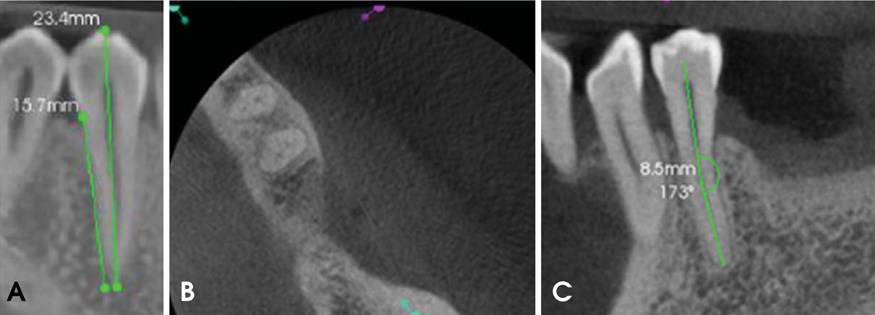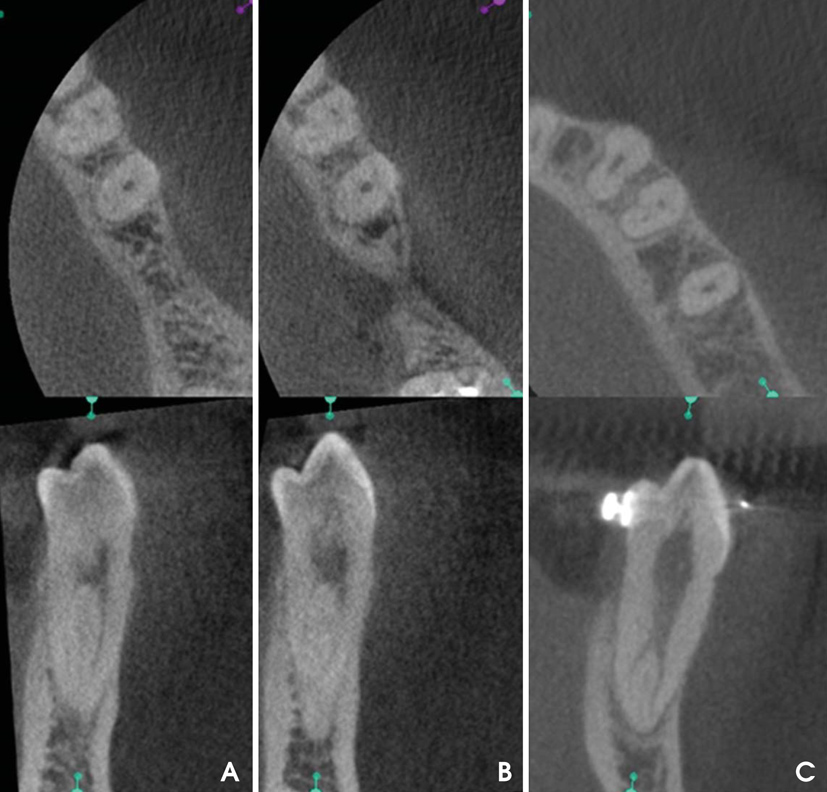Imaging Sci Dent.
2014 Sep;44(3):221-227. 10.5624/isd.2014.44.3.221.
Cone-beam computed tomography analysis of root and canal morphology of mandibular premolars in a Spanish population
- Affiliations
-
- 1Department of Stomatology, Universitat de Valencia, Valencia, Spain. llena@uv.es
- 2Fernandez Ugedo y Chaves Clinic, Alicante, Spain.
- KMID: 1974486
- DOI: http://doi.org/10.5624/isd.2014.44.3.221
Abstract
- PURPOSE
This study aimed to investigate the clinical anatomy of lower premolar roots in a Spanish population by using cone-beam computed tomography (CBCT), correlating findings with patient gender and tooth type.
MATERIALS AND METHODS
Using 70 CBCT images, we evaluated 126 healthy, untreated, well-developed lower premolars. The number and morphology of roots and root canals, and the foramina number were assessed. Results for gender and tooth type were compared using the chi-squared and ANOVA tests.
RESULTS
The average length of teeth and roots was significantly higher in men (p=0.00). All 126 premolars had a single root. One canal was found in 83.3% of the premolars, with no gender or tooth type differences; Vertucci configuration types I and V were the most prevalent. The first premolars showed significantly greater variability than the second premolars (p=0.03). A single apical foramen was found in 89.7% of the premolars, with no differences by tooth type. Women had a significantly higher prevalence of two apical foramina than men (p=0.04). Some degree of curvature was observed in 65% of the premolars, with no differences by gender or tooth type. A root angle of more than 20degrees was found in 12.98% of the premolars, without any differences by gender or tooth.
CONCLUSION
All premolars were single-rooted. One canal had the most prevalent morphology. More variability in canal anatomy was found in the first premolars. Curvatures greater than 20degrees were found at less than 5 mm from the apex.
MeSH Terms
Figure
Reference
-
1. Miracle AC, Mukherji SK. Conebeam CT of the head and neck, part 2: clinical applications. AJNR Am J Neuroradiol. 2009; 30:1285–1292.
Article2. Yajima A, Otonari-Yamamoto M, Sano T, Hayakawa Y, Otonari T, Tanabe K, et al. Cone-beam CT (CB Throne) applied to dentomaxillofacial region. Bull Tokyo Dent Coll. 2006; 47:133–141.
Article3. Scarfe WC, Farman AG, Sukovic P. Clinical applications of cone-beam computed tomography in dental practice. J Can Dent Assoc. 2006; 72:75–80.4. Madrigal C, Ortega R, Meniz C, López-Quiles J. Study of available bone for interforaminal implant treatment using conebeam computed tomography. Med Oral Patol Oral Cir Bucal. 2008; 13:E307–E312.5. Scarfe WC, Levin MD, Gane D, Farman AG. Use of cone beam computed tomography in endodontics. Int J Dent. 2009; 2009:634567.
Article6. Patel S. New dimensions in endodontic imaging: part 2. Cone beam computed tomography. Int Endod J. 2009; 42:463–475.
Article7. Patel S, Horner K. The use of cone beam computed tomography in endodontics. Int Endod J. 2009; 42:755–756.
Article8. Zillich R, Dowson J. Root canal morphology of mandibular first and second premolars. Oral Surg Oral Med Oral Pathol. 1973; 36:738–744.
Article9. Slowey RR. Root canal anatomy. Road map to successful endodontics. Dent Clin North Am. 1979; 23:555–573.10. Glassman GD. Flare-up with associated paresthesia of a mandibular second premolar with three root canals. Oral Surg Oral Med Oral Pathol. 1987; 64:110–113.
Article11. Cleghorn BM, Christie WH, Dong CC. The root and root canal morphology of the human mandibular first premolar: a literature review. J Endod. 2007; 33:509–516.
Article12. Cleghorn BM, Christie WH, Dong CC. The root and root canal morphology of the human mandibular second premolar: a literature review. J Endod. 2007; 33:1031–1037.
Article13. Rahimi S1, Shahi S, Yavari HR, Manafi H, Eskandarzadeh N. Root canal configuration of mandibular first and second premolars in an Iranian population. J Dent Res Dent Clin Dent Prospects. 2007; 1:59–64.14. Park JB, Kim N, Park S, Kim Y, Ko Y. Evaluation of root anatomy of permanent mandibular premolars and molars in a Korean population with cone-beam computed tomography. Eur J Dent. 2013; 7:94–101.15. Trope M, Elfenbein L, Tronstad L. Mandibular premolars with more than one root canal in different race groups. J Endod. 1986; 12:343–345.
Article16. Hulsmann M. Mandibular first premolar with three root canals. Endod Dent Traumatol. 1990; 6:189–191.
Article17. Yang ZP. Multiple canals in a mandibular first premolar. Case report. Aust Dent J. 1994; 39:18–19.
Article18. Nallapati S. Three canal mandibular first and second premolars: a treatment approach. J Endod. 2005; 31:474–476.19. Kakkar P, Singh A. Mandibular first premolar with three roots: a case report. Iran Endod J. 2012; 7:207–210.20. Yu X, Guo B, Li KZ, Zhang R, Tian YY, Wang H, et al. Conebeam computed tomography study of root and canal morphology of mandibular premolars in a western Chinese population. BMC Med Imaging. 2012; 12:18.
Article21. Michetti J, Maret D, Mallet JP, Diemer F. Validation of cone beam computed tomography as a tool to explore root canal anatomy. J Endod. 2010; 36:1187–1190.
Article22. Vertucci FJ. Root canal anatomy of the human permanent teeth. Oral Surg Oral Med Oral Pathol. 1984; 58:589–599.
Article23. Khedmat S, Assadian H, Saravani AA. Root canal morphology of the mandibular first premolars in an Iranian population using cross-sections and radiography. J Endod. 2010; 36:214–217.
Article24. Tzanetakis GN, Lagoudakos TA, Kontakiotis EG. Endodontic treatment of a mandibular second premolar with four canals using operating microscope. J Endod. 2007; 33:318–321.
Article25. Awawdeh LA, Al-Qudah AA. Root form and canal morphology of mandibular premolars in a Jordanian population. Int Endod J. 2008; 41:240–248.
Article26. Kim Y, Lee SJ, Woo J. Morphology of maxillary first and second molars analyzed by cone-beam computed tomography in a Korean population: variations in the number of roots and canals and the incidence of fusion. J Endod. 2012; 38:1063–1068.
Article27. Zhang R, Yang H, Yu X, Wang H, Hu T, Dummer PM. Use of CBCT to identify the morphology of maxillary permanent molar teeth in a Chinese subpopulation. Int Endod J. 2011; 44:162–169.
Article28. Zheng Q, Zhang L, Zhou X, Wang Q, Wang Y, Tang L, et al. C-shaped root canal system in mandibular second molars in a Chinese population evaluated by cone-beam computed tomography. Int Endod J. 2011; 44:857–862.
Article29. Reis AG, Grazziotin-Soares R, Barletta FB, Fontanella VR, Mahl CR. Second canal in mesiobuccal root of maxillary molars is correlated with root third and patient age: a cone-beam computed tomographic study. J Endod. 2013; 39:588–592.
Article30. Demirbuga S, Sekerci AE, Dinçer AN, Cayabatmaz M, Zorba YO. Use of cone-beam computed tomography to evaluate root and canal morphology of mandibular first and second molars in Turkish individuals. Med Oral Patol Oral Cir Bucal. 2013; 18:e737–e744.
Article31. Silva EJ, Nejaim Y, Silva AV, Haiter-Neto F, Cohenca N. Evaluation of root canal configuration of mandibular molars in a Brazilian population by using cone-beam computed tomography: an in vivo study. J Endod. 2013; 39:849–852.32. Kim E, Fallahrastegar A, Hur YY, Jung IY, Kim S, Lee SJ. Difference in root canal length between Asians and Caucasians. Int Endod J. 2005; 38:149–151.
Article33. Vertucci FJ. Root canal morphology of mandibular premolars. J Am Dent Assoc. 1978; 97:47–50.
Article34. Green D. Double canals in single roots. Oral Surg Oral Med Oral Pathol. 1973; 35:689–696.
Article35. Lu TY, Yang SF, Pai SF. Complicated root canal morphology of mandibular first premolar in a Chinese population using the cross section method. J Endod. 2006; 32:932–936.
Article36. Willershausen B, Kasaj A, Röhrig B, Briseño B. The determination of the initial straight length in root canals of mandibular premolars - an in vitro study. Eur J Med Res. 2009; 14:85–89.37. Lombart B, Michonneau JC. Premolar anatomy and endodontic treatment. Rev Belge Med Dent (1984). 2005; 60:322–336.
- Full Text Links
- Actions
-
Cited
- CITED
-
- Close
- Share
- Similar articles
-
- Observation of mandibular second molar roots and root canal morphology using dental cone-beam computed tomography
- Characterization of mandibular molar root and canal morphology using cone beam computed tomography and its variability in Belgian and Chilean population samples
- Prevalence and features of distolingual roots in mandibular molars analyzed by cone-beam computed tomography
- Cone-beam computed tomography observation of maxillary first premolar canal shapes
- Reliability of panoramic radiography in predicting proximity of third molars to the mandibular canal: A comparison using cone-beam computed tomography



